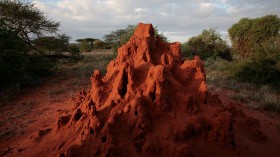Attenborough's long-beaked echidna, a long-thought-extinct animal named after British naturalist David Attenborough, was rediscovered in the Cyclops Mountains in the Indonesian part of New Guinea island.
The long-lost species was spotted again during a scientific expedition on the said island led by researchers from Oxford University in England.
Prior to the breakthrough sighting, the only evidence of the animal was a collected specimen placed in a museum, according to reports.
Also called Sir David's long-beaked echidna or the Cyclops long-beaked echidna, is a peculiar mammal since its appearance resembles the spines of a hedgehog, the feet of a mole, and the snout of an anteater.
The spiky animal was last seen more than 60 years ago in the same area, Indonesia's Cyclops Mountains.
The researchers recorded the wild animal when it passed through one of their trail cameras during the last day of their 1-month expedition.
Extinct Animal Rediscovered
The expedition to the Cyclops Mountains, located in the Indonesian province of Papua, was led by James Kempton, who reportedly stated that his team collected thousands of specimens from thousands of invertebrates, as well as specimens from almost 100 frogs and reptiles.
However, what they discovered in the wild answered a decades-long mystery that involved the seemingly sudden disappearance of Attenborough's long-beaked echidna.
The camera sighting of Sir David's long-beaked echidna is the first-ever digital recording of the long-lost animal with the scientific name Zaglossus attenboroughi, under the phylum Chordata.
It is also one of the three species belonging to the genus Zaglossus that is native to New Guinea.
The video captured by the Oxford University researchers has been circulating throughout social media since Friday, November 10.
In the 30-second clip, the first footage of the rare long-beaked echidna shows the animal wandering the wilderness of the Cyclops Mountains at night.
Also Read: Australia's Extinct Long-Beaked Echidna May Still Exist
Attenborough's Long-Beaked Echidna
As mentioned earlier, it has been decades already since Attenborough's long-beaked echidna was last spotted by scientists in 1961, a time when they also called the only known specimen of the egg-laying mammal. Despite reports of their extinction before or designation as an extremely rare animal, there are still people who believe that the long-beaked echidna never disappeared at all in the first place.
In a 2009 research article published by the Cambridge University Press, fieldwork was carried out by scientists in the northern and southern parts of the Cyclops Mountains to investigate the 'continued survival of Z. attenboroughi' by using methods like community interviews, sign surveys, and visual encounter surveys.
Survey results from the research showed that many local villagers recognized photographs of Sir David's long-beaked echidna and they were able to describe some biological features of the said animals. They even reported several recent sightings at that time in areas with below 300-meter elevation, where they called the animal "payangko."
However, there was no evidence of the survival of Attenborough's long-beaked echidna from the 2009 research, until more than a decade later when doubts about its continued existence finally ended.
Related Article: Endangered Anteaters: Long-Beaked Echidnas Successfully Bred By Conservationists
© 2024 NatureWorldNews.com All rights reserved. Do not reproduce without permission.





